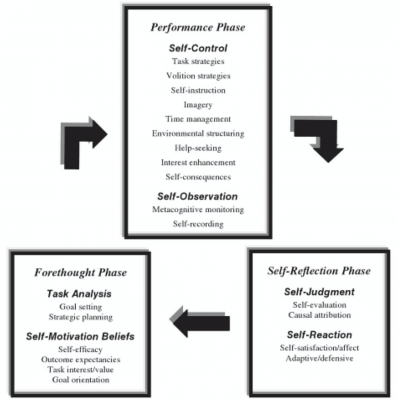Welcome to the module on the intersection of pedagogy and technology for the online classroom
In addition to public safety and social distancing, distance learning is often the preferred environment due to its flexibility in terms of time and pace of learning. However, in absence of a classroom teacher, student freedom comes with added personal responsibility. Online learners must self regulate, including organizing their own learning spaces, their weekly calendars, their daily schedules, and continuously monitor whether they are going too face, too slow, whether they understanding or missing information, and whether they should persist toward a solution or take a break or pursue a different approach.

S elf-regulation is the regulation of one’s thinking and actions (Zimmerman & Schunk, 2011). It generally includes forethought about what to do and how, monitoring of performance to ensure one is making progress, and then some ongoing reflection about strategy and progress through comprehension checks and self assessments. It also includes self control to do work over more immediately rewarding options (see the marshmallow test in the image).
elf-regulation is the regulation of one’s thinking and actions (Zimmerman & Schunk, 2011). It generally includes forethought about what to do and how, monitoring of performance to ensure one is making progress, and then some ongoing reflection about strategy and progress through comprehension checks and self assessments. It also includes self control to do work over more immediately rewarding options (see the marshmallow test in the image).
There is evidence to suggest that students do better at self control and persistence when teamed up with fellow students (e.g., Koomen, Grueneisen, & Herrmann, 2020). While teacher know that self regulation is a good skill for all learners, they often underestimate how much support they provide to students when in the in-person classroom, and how much some students may struggle without those little nudges, shoulder taps, and “teacher’s stare” in class to get on task and persist.
Teacher Education has experienced criticisms that preparation programs often feature disconnected courses that are purely theoretical and do not, in the end, produce new teachers who have the critical teaching skills needed to be successful in the classroom from the start. In response to such criticisms, some organizations involved in preparing and developing teachers have identified core practices that all teachers should be able to do and created new standards for teacher prep programs (sorry you’ll have to create a free account to read this full EdWeek article).
For example, Edutopia lists 16 “habits of mind” that should be represented in teacher work and in nearly all teacher instruction, including finding humor and supporting creativity.
In a similar vein, the University of Michigan has listed 19 high leverage core teaching practices. These are “high leverage” because they should be able to touch on nearly every methods course content or inservice experience that teachers experience, such as teachers being able to establish classroom norms, choosing and adapting existing materials for specific classroom learning outcomes, organizing small group collaborative work, and leading whole classroom discussions and activity debriefings.
For this challenge, you are invited to consider how technology can be wisely integrated in support of any and all of these core practices and so-called “habits of mind.” This module specifically seeks for you to consider what they “core practices” known to be a key part of all teaching, look like in hybrid and online coursework. To anchor your work on this challenge, the following class scenario is provided.
Some Background on Good Pedagogy (in general)
Consider the 14 APA Learner-centered Principles
Revisit the 19 U Michigan high leverage core practices
and the Edutopia 16 Habits of Mind for teachers.
Koomen, R., Grueneisen, S., & Herrmann, E. (2020). Children delay gratification for cooperative ends. Psychological Science, 31(2), 139–148. https://doi-org.ezproxy.lib.uconn.edu/10.1177/0956797619894205
Wandler, J., & Imbriale, W. (2017). Promoting undergraduate student self-regulation in online learning environments. Online Learning 21:2. doi: 10.24059/olj.v21i2.881
Each Year the Horizon Project identifies emerging technologies and trends. Download their latest report and consider reviewing the executive summaries of the past 2 or 3 years. Compare the trends.
Next read how computer savvy students use computers vs how teachers use computers:
- Students differ in how they use computers at home and at school for learning
- There can be quite a difference in priorities for computer use at home and at school
Then consider the Digital Divide:
- Steele, C. (2019) on the Digital Divide
Are Video Games a learner-centered learning environment if by playing Pirates! you learn history or at least understand Spanish colonization?
What are the “big ideas” you’ve learned from studying Learning Theory? Would you agree they include the following?:
- Practice (makes perfect)
- Active, hands-on, “interactive”
- Integrated across curricular domains
- Collaborative and social (involving team or peers)
- Supported by family, peers, and culture
- Developmentally appropriate (allowing “levels” of challenge)
Enduring Understanding- Student Learning Outcome from this module
This module intends provide an authentic case of technology integration and encourage a discussion of how Ms Robson is doing with regard to the wise use of tech to create an innovative, engaging and effective learning environment for her students that aligns with TPACK and represents the Transformation level of the SAMR framework.
